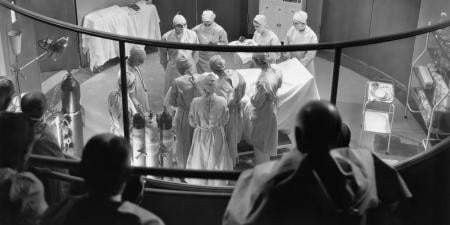Abstract
Enhanced recovery after surgery (ERAS®) protocols vary by surgery type. This article examines benefits of ERAS pathways, compares ERAS pathways to traditional protocols from clinical and ethical standpoints, and discusses formal recommendations of the American College of Surgeons, the American Society of Anesthesiologists, and other groups.
Need for Better Pain Management
Surgical pain begins at incision and can last for days, weeks, or even years after surgery.1 Traditionally, anesthesiologists manage pain during surgery and immediately afterward in the recovery area. As patients transition to their hospital bed and then home, surgeons take over pain management. However, a more collaborative and evidence-based approach is needed, given the wide variations that exist in postoperative opioid prescriptions for the same surgery2 and the risk of opioid addiction. In the face of the opioid epidemic, much attention has been paid to how and when addiction begins. A recent review of 6 studies found that 67% to 92% of surgical patients reported unused opioids.3 Sadly, 3 of 4 users of heroin begin by using prescription drugs.4 Unused and leftover prescription drugs at home contribute to addiction, as 44% of those who misuse opioids identify family members as a source of prescription opioids and 88% identify friends as a source.5 Given these staggering statistics, cautious and thoughtful perioperative pain planning is necessary to decrease the use of opioids at the hospital and reduce unused pills at home. Such planning is being accomplished through enhanced recovery after surgery (ERAS®) pathways, which implement evidence-based opioid prescribing guidelines.6,7,8
Benefits of ERAS Pathways
ERAS pathways involve collaboration between anesthesiologists and surgeons to improve patient care. These pathways include optimizing preoperative medical care; standardizing intraoperative fluid and ventilation management and employing epidural or regional anesthesia (ie, numbing medicine around the nerves of the spine and periphery, respectively) in conjunction with, or in addition to, general anesthesia; and postoperatively prescribing multimodal pain medications and encouraging early ambulation and removal of lines and drains.7,9,10,11 The evidence-based medical interventions applied during ERAS pathways are aimed at improving normal recovery after an operation and at preventing common problems such as pain, nausea, urinary tract infections, pneumonia, delirium, and delay in return of bowel function. The solution to many of these problems is early mobilization facilitated by nonsedating pain control. These pathways have shown encouraging results, including decreased length of hospital stay, fewer complications, cost savings, and a reduced 2-year mortality rate.7,9,10,11
Studies have also shown a decrease in opioid use in patients on an ERAS pathway.7,9 While opioids control acute pain quickly, many deleterious side effects can accompany their use such as sedation, a decreased drive to breathe, a delay in the return of bowel function, and nausea or vomiting.12,13 Epidural and regional anesthesia can be more effective in controlling pain, as they work to prevent pain transmission.12 Controlling postsurgical pain well with nonnarcotic pain medications and other modalities such as an epidurals or nerve blocks contributes to early mobilization and decreased time to discharge.7,9,10,11 As ERAS pathways evolve, more attention is being dedicated to discharge opioid planning as well. Opioid stewardship is an additional key component of ERAS pathways that highlights how collaboration between anesthesiologists and surgeons can provide benefits beyond the perioperative period. Given the success of ERAS pathways,7,9,10,11 the number of pathways is growing,11 and the ERAS society currently has 22 separate reviews and recommendations.14
Comparison of ERAS Pathway to Traditional Protocol
The creation of an ERAS pathway begins when a multidisciplinary team, including anesthesiologists and surgeons, meets to discuss a particular surgery. A patient undergoing an ERAS pathway will have a very different experience than one undergoing a traditional protocol. Imagine that 2 men of similar age and medical history are having a section of their lung removed through a large chest wall incision, but at different hospitals with different perioperative protocols. The following narrative illuminates how collaborative treatment planning can change patient outcomes.
Studies have also shown a decrease in opioid use in patients on an ERAS pathway.
Mr Smith’s journey through surgery could be described as follows: at his visit with the surgeon prior to surgery, he receives an incentive spirometer (IS), which is a machine to help him perform deep breathing exercises. He will bring the IS with him to the hospital to perform frequent exercises after surgery to help prevent pneumonia. Additionally, he meets with the anesthesiologist at a clinic for evaluation to ensure that he is medically optimized and appropriate for surgery. He is told which of his medications to take the day of surgery and is instructed to drink a bottle of an electrolyte solution 2 hours prior to arriving at the hospital. On the morning of surgery, he is given nonnarcotic pain medication, including acetaminophen, pregabalin, and celecoxib, to help minimize pain before it begins. He also receives a thoracic epidural for pain control. During surgery, the anesthesiologist infuses numbing and narcotic medication through the epidural to prevent the transmission of pain. This epidural will stay in place after surgery until his chest tube is removed and he is able to take medications by mouth.7 Medications in the epidural space have a fraction of the systemic penetration compared to those given intravenously or by mouth, and therefore much less medication is needed.12 Epidurals also enhance the return of bowel function through a number of mechanisms.12,13 Mr Smith’s chest tube and foley catheter are removed on postoperative day 2. His pain is well controlled, and he tolerates foods well, so his epidural is removed on postoperative day 3. He has opioid medications as needed and is on scheduled nonopioid medications for pain control. Mr Smith’s daily opioid requirement over the past 24 hours is calculated, and, based on his past needs and an evidence-based guideline for opioid discharge prescribing,15 he is sent home with a prescription that consists of 21 opioid pills.He leaves the hospital on postoperative day 4.
Across town, Mr Jones presents for the same surgery but has a different experience without an ERAS pathway in place. He is unsure which medications to take on the day of surgery, so he doesn’t take any of them and his blood sugar and blood pressure are poorly controlled prior to surgery. He is dehydrated because he has not had anything to eat or drink since 8 pm the prior evening, and it is very difficult for the nurses to place an intravenous catheter. The anesthesiologist and surgeon meet in the operating room and the surgery begins. The 2 physicians disagree on proper fluid management intraoperatively. The surgeon fears too much fluid will compromise breathing postoperatively, and the anesthesiologist notes that, based on lab values and vital signs, the patient needs more fluid. Mr Jones is given a large amount of opioids intraoperatively due to elevated heart rate and blood pressure indicating pain. After surgery, he requires high doses of intravenous opioids and complains of pain with deep breathing. He becomes drowsy and confused at night and his wife must remain at his bedside to reorient him. His bowels are slow to wake up and he is nauseous. On postoperative day 4, he begins to walk and his bowels wake up, and on postoperative day 5, his chest tube is removed. On postoperative day 6, he goes home with a prescription for 84 opioid pills, the number his surgeon has always prescribed for each patient.
The difference between Mr Smith’s and Mr Jones’ outcomes seems to beg the question, why doesn’t every surgery have an ERAS pathway? Each patient comes to surgery with a unique medical history, and the anesthesiologist and surgeon must take that into consideration when planning for that patient’s care, realizing that some patients are not candidates for components of ERAS pathways. For example, a patient having a thoracotomy or colectomy who remains on blood thinners is not safely able to receive an epidural. The barriers to implementation may also lie in the fact that necessary teaching and planning would require time, effort, and resources. There are costs associated with the initiation of the pathways, but, ultimately, ERAS pathways have been shown to save money.7,9,10,11 The largest obstacle is likely changing the practice habits of physicians—particularly if they have been performing surgery “successfully” for a number of years. Why would an epidural or nerve block, which is a procedure not without risk, be beneficial if patients historically have been discharged safely postoperatively? The answer to that question lies in the data emerging from ERAS pathways, which show decreased patient complications, opioid requirements, and length of stay.7,11 Practice habits should evolve to serve patients better.
Opioid Stewardship
In the midst of the opioid epidemic, it has become clear that each component of perioperative care, including discharge medications, requires careful thought for patient safety.4,5 The opioid problem in this country can be attributed in part to perioperative opioids, and national organizations have made clear statements instructing their members to use alternative pain control strategies.1,2,3,4,5 The American College of Surgeons and the American Society of Anesthesiologists both advocate using alternatives to opioids for pain control whenever possible and basing opioid discharge prescriptions on calculated use.15,16,17 The website of the American College of Surgeons explicitly states that the surgical team will “use alternatives to opioids whenever possible” and advocates for “using the lowest dose of opioids for the shortest amount of time.”16 Additionally, the association’s current guidelines for opioid discharge prescriptions instruct surgeons to analyze the patient’s opioid use during the last 24 hours of a patient’s hospital stay to determine the discharge prescription.15 For example, a patient who used 3 opioid doses within the last 24 hours would go home with a prescription for 21 pills. Similarly, the American Society of Anesthesiologists’ updated guidelines for postoperative pain management recommend use of neuraxial opioids and peripheral nerve blocks.17 The development and implementation of such evidence-based postoperative opioid prescribing guidelines is an important initiative in both ERAS pathways and hospital systems at large.6,15
In an effort to guide discharge opioid prescribing, researchers at the University of Michigan (UM) and the University of North Carolina (UNC) surveyed patients on their postoperative use of opioids. At UM, they found that “the median prescription size was 250 mg (OME) [oral morphine equivalents], while median patient use was only 30 mg. This is equivalent to receiving 50 tablets of hydrocodone/acetaminophen, 5/325 mg, and using only 6 tablets.”6 Similarly, at UNC, follow-up interviews with patients revealed that the vast majority of patients used less than half of their prescription. With this information, UNC’s Opioid Stewardship Steering Committee (with which the second author is affiliated) created prescribing recommendations to guide surgeons based on specific surgical procedures. Within a year of implementing these “right-sized” opioid prescriptions, 367 756 fewer opioid pills were prescribed than in the previous year.
Evidence-based prescribing programs are examples of perioperative collaboration designed to decrease misuse of opioids through precision opioid prescribing, clinician and patient education, and safe storage and disposal of unused opioids. Decreasing the number of leftover pain pills can help prevent opioid misuse and addiction on the part of both patients and their families and friends. ERAS pathways, including perioperative opioid stewardship programs led by anesthesiologists and surgeons, greatly improve patient care and positively impact society.
References
- Alam A, Gomes T, Zheng H, Mamdani MM, Juurlink DN, Bell CM. Long-term analgesic use after low-risk surgery: a retrospective cohort study. Arch Intern Med. 2012;172(5):425-430.
- Hill MV, McMahon ML, Stucke RS, Barth RJ Jr. Wide variation and excessive dosage of opioid prescriptions for common general surgical procedures. Ann Surg. 2017;265(4):709-714.
- Bicket MC, Long JJ, Pronovost PJ, Alexander GC, Wu CL. Prescription opioid analgesics commonly unused after surgery: a systematic review. JAMA Surg. 2017;152(11):1066-1071.
- Jones CM. Heroin use and heroin use risk behaviors among nonmedical users of prescription opioid pain relievers—United States, 2002-2004 and 2008-2010. Drug Alcohol Depend. 2013;132(1-2):95-100.
- Daniulaityte R, Falck R, Carlson RG. Sources of pharmaceutical opioids for non-medical use among young adults. J Psychoactive Drugs. 2014;46(3):198-207.
- Howard R, Waljee J, Brummett C, Englesbe M, Lee J. Reduction in opioid prescribing through evidence-based prescribing guidelines. JAMA Surg. 2018;153(3):285-287.
- Ljungqvist O, Scott M, Fearon KC. Enhanced recovery after surgery: a review. JAMA Surg. 2017;152(3):292-298.
-
Mark J, Argentieri DM, Gutierrez CA, et al. Ultrarestrictive opioid prescription protocol for pain management after gynecologic and abdominal surgery. JAMA Netw Open. 2018;1(8):e185452.
- Semenkovich TR, Hudson JL, Subramanian M, Kozower BD. Enhanced recovery after surgery (ERAS) in thoracic surgery. Semin Thorac Cardiovasc Surg. 2018;30(3):342-349.
- Martin LW, Sarosiek BM, Harrison MA, et al. Implementing a thoracic enhanced recovery program: lessons learned in the first year. Ann Thorac Surg. 2018;105(6):1597-1604.
-
Smith TW Jr, Wang X, Singer MA, Godellas CV, Vaince FT. Enhanced recovery after surgery: a clinical review of implementation across multiple surgical subspecialties [published online ahead of print November 16, 2019]. Am J Surg.
-
Butterworth J. Morgan and Mikhail’s Clinical Anesthesiology. 5th ed. New York, NY: McGraw-Hill; 2013.
- Sanfilippo F, Spoletini G. Perspectives on the importance of postoperative ileus. Curr Med Res Opin. 2015;31(4):675-676.
-
ERAS® Society. List of guidelines. https://erassociety.org/guidelines/list-of-guidelines. Accessed January 2, 2019.
- Hill MV, Stucke RS, Billmeier SE, Kelly JL, Barth RJ Jr. Guideline for discharge opioid prescriptions after inpatient general surgical procedures. J Am Col Surg. 2018;226(6):996-1003.
-
American College of Surgeons. Surgical patient education program: common questions. https://www.facs.org/education/patient-education/safe-pain-control/common-questions#q1. Accessed October 6, 2019.
- American Society of Anesthesiologists Task Force on Acute Pain Management. Practice guidelines for acute pain management in the perioperative setting: an updated report by the American Society of Anesthesiologists Task Force on Acute Pain Management. Anesthesiology. 2012;116(2):248-273.



